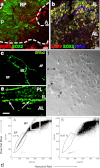Pituitary stem cell update and potential implications for treating hypopituitarism
- PMID: 21493869
- PMCID: PMC3369576
- DOI: 10.1210/er.2010-0011
Pituitary stem cell update and potential implications for treating hypopituitarism
Abstract
Stem cells have been identified in organs with both low and high cell turnover rates. They are characterized by the expression of key marker genes for undifferentiated cells, the ability to self-renew, and the ability to regenerate tissue after cell loss. Several recent reports present evidence for the presence of pituitary stem cells. Here we offer a critical review of the field and suggest additional studies that could resolve points of debate. Recent reports have relied on different markers, including SOX2, nestin, GFRa2, and SCA1, to identify pituitary stem cells and progenitors. Future studies will be needed to resolve the relationships between cells expressing these markers. Members of the Sox family of transcription factors are likely involved in the earliest steps of pituitary stem cell proliferation and the earliest transitions to differentiation. The transcription factor PROP1 and the NOTCH signaling pathway may regulate the transition to differentiation. Identification of the stem cell niche is an important step in understanding organ development. The niche may be the marginal zone around the lumen of Rathke's pouch, between the anterior and intermediate lobes of mouse pituitary, because cells in this region apparently give birth to all six pituitary hormone cell lineages. Stem cells have been shown to play a role in recurrent malignancies in some tissues, and their role in pituitary hyperplasia, pituitary adenomas, and tumors is an important area for future investigation. From a therapeutic viewpoint, the ability to cultivate and grow stem cells in a pituitary predifferentiation state might also be helpful for the long-term treatment of pituitary deficiencies.
Figures




Similar articles
-
A GRFa2/Prop1/stem (GPS) cell niche in the pituitary.PLoS One. 2009;4(3):e4815. doi: 10.1371/journal.pone.0004815. Epub 2009 Mar 13. PLoS One. 2009. PMID: 19283075 Free PMC article.
-
Craniopharyngiomas express embryonic stem cell markers (SOX2, OCT4, KLF4, and SOX9) as pituitary stem cells but do not coexpress RET/GFRA3 receptors.J Clin Endocrinol Metab. 2012 Jan;97(1):E80-7. doi: 10.1210/jc.2011-2187. Epub 2011 Oct 26. J Clin Endocrinol Metab. 2012. PMID: 22031517
-
Paired-related homeodomain proteins Prx1 and Prx2 are expressed in embryonic pituitary stem/progenitor cells and may be involved in the early stage of pituitary differentiation.J Neuroendocrinol. 2012 Sep;24(9):1201-12. doi: 10.1111/j.1365-2826.2012.02336.x. J Neuroendocrinol. 2012. PMID: 22577874
-
Pituitary Cell Turnover: From Adult Stem Cell Recruitment through Differentiation to Death.Neuroendocrinology. 2015;101(3):175-92. doi: 10.1159/000375502. Epub 2015 Feb 5. Neuroendocrinology. 2015. PMID: 25662152 Review.
-
Genetic determinants of mammalian pituitary morphogenesis.Front Biosci. 2007 Jan 1;12:125-34. doi: 10.2741/2053. Front Biosci. 2007. PMID: 17127288 Review.
Cited by
-
Single-cell analysis reveals a nestin+ tendon stem/progenitor cell population with strong tenogenic potentiality.Sci Adv. 2016 Nov 18;2(11):e1600874. doi: 10.1126/sciadv.1600874. eCollection 2016 Nov. Sci Adv. 2016. PMID: 28138519 Free PMC article.
-
Evidence for a Neogenic Niche at the Periphery of Pancreatic Islets.Bioessays. 2018 Nov;40(11):e1800119. doi: 10.1002/bies.201800119. Epub 2018 Sep 28. Bioessays. 2018. PMID: 30264410 Free PMC article. Review.
-
Localization of SOX2-positive stem/progenitor cells in the anterior lobe of the common marmoset (Callithrix jacchus) pituitary.J Reprod Dev. 2018 Oct 12;64(5):417-422. doi: 10.1262/jrd.2018-043. Epub 2018 Jul 21. J Reprod Dev. 2018. PMID: 30033984 Free PMC article.
-
Pituitary gland development and disease: from stem cell to hormone production.Curr Top Dev Biol. 2013;106:1-47. doi: 10.1016/B978-0-12-416021-7.00001-8. Curr Top Dev Biol. 2013. PMID: 24290346 Free PMC article. Review.
-
Components of the canonical and non-canonical Wnt pathways are not mis-expressed in pituitary tumors.PLoS One. 2013 Apr 26;8(4):e62424. doi: 10.1371/journal.pone.0062424. Print 2013. PLoS One. 2013. PMID: 23638078 Free PMC article.
References
-
- Murry CE, Keller G. 2008. Differentiation of embryonic stem cells to clinically relevant populations: lessons from embryonic development. Cell 132:661–680 - PubMed
-
- Yoshimura F, Harumiya K, Ishikawa H, Otsuka Y. 1969. Differentiation of isolated chromophobes into acidophils or basophils when transplanted into the hypophysiotrophic area of hypothalamus. Endocrinol Jpn 16:531–540 - PubMed
-
- Chen J, Hersmus N, Van Duppen V, Caesens P, Denef C, Vankelecom H. 2005. The adult pituitary contains a cell population displaying stem/progenitor cell and early embryonic characteristics. Endocrinology 146:3985–3998 - PubMed
-
- Vidal S, Horvath E, Kovacs K, Cohen SM, Lloyd RV, Scheithauer BW. 2000. Transdifferentiation of somatotrophs to thyrotrophs in the pituitary of patients with protracted primary hypothyroidism. Virchows Arch 436:43–51 - PubMed
-
- Thodou E, Asa SL, Kontogeorgos G, Kovacs K, Horvath E, Ezzat S. 1995. Clinical case seminar: lymphocytic hypophysitis: clinicopathological findings. J Clin Endocrinol Metab 80:2302–2311 - PubMed
Publication types
MeSH terms
Grants and funding
LinkOut - more resources
Full Text Sources
Miscellaneous

